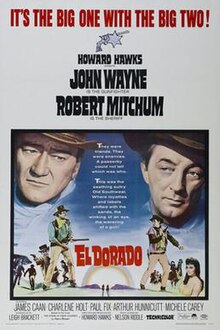Opening Credits:
The paintings in the opening credits are those of artist Olaf Wieghorst, who also makes a brief appearance as Swede Larsen in the film.
| El Dorado | |
|---|---|

Theatrical release poster
|
|
The musical score was composed by Nelson Riddle.
John Wayne’s horse was a six-year-old Appaloosa stallion named Zip and features more prominently in the plot than other horses.
How the Script Kept Changing
Leigh Brackett wrote the original script, which she described as “the best script I had ever done in my life. It wasn’t tragic, but it was one of those things where Wayne died at the end.” However, she said that as production neared, “the more we got into doing Rio Bravo over again the sicker I got, because I hate doing things over again. And I kept saying to Howard I did that, and he’d say it was okay, we could do it over again.”
No Story, Just Characters
Robert Mitchum later said: “When Howard called me, I said, ‘What’s the story?’ and he said, ‘No story, just characters’ and that’s the way it was. Did one scene, put it away, did another, put it away.”
Cinematographer Harold Rosson: Last Film
Cinematographer Harold Rosson had retired in 1958, but Hawks persuaded him to come back to work. After making the film, Rosson resumed his retirement permanently.
El Dorado was shot in Technicolor at Old Tucson Studios just west of Tucson, Arizona as well as in and around Kanab, Utah from October 1965 to January 1966.
The film, Wayne’s 138th picture, was shot before The War Wagon, but its release was delayed so that Paramount’s Nevada Smith with the major star Steve McQueen would not have to compete with a John Wayne film at the box office.
Premiering n Japan six months before America, El Dorado finally reached the theatres in June 1967, a month after The War Wagon had opened.
The film was the only screen pairing between John Wayne and Robert Mitchum, though they both appear, separately, in the WWII epic, The Longest Day.
Hawks Trilogy
El Dorado is the second of three films directed by Hawks about a sheriff defending his office against belligerent outlaw elements, coming after Rio Bravo (1959) and before Rio Lobo (1970), both also starring Wayne in similar roles.
The poem repeated in the film and paraphrased in the theme song is “Eldorado,” a ballad poem by Edgar Allan Poe.
Footage from El Dorado was later incorporated into the opening montage of Wayne’s final film, The Shootist, in 1976, to illustrate the backstory of Wayne’s character.
Credits:
Produced, directed by Howard Hawks
Screenplay by Leigh Brackett, based on The Stars in Their Courses, 1960 novel by Harry Brown
Produced by Howard Hawks
Starring
John Wayne
Robert Mitchum
James Caan
Charlene Holt
Paul Fix
Arthur Hunnicutt
Michele Carey
Cinematography Harold Rosson
Edited by John Woodcock
Music by Nelson Riddle
Production
company
Laurel Productions
Distributed by Paramount Pictures
Release dates
December 17, 1966 (Japan)
June 7, 1967 (USA)
Running time
126 minutes
Country United States
Language English
Budget $4,653,000[1]
Box office $5,950,000 (US/ Canada)[N



